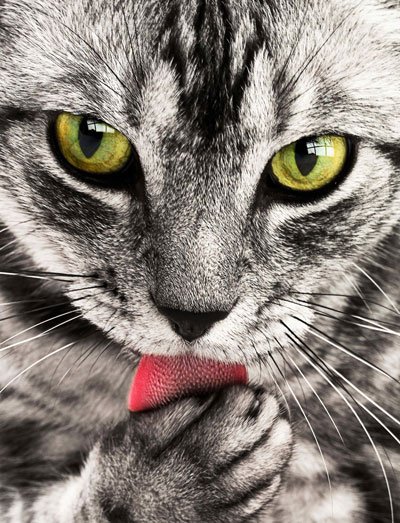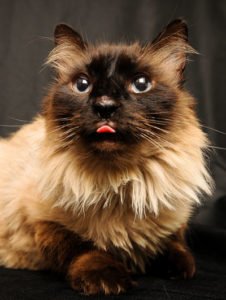The Deep-Cleaning Power of Cat Tongues

Cats are remarkably fussy creatures who spend up to 50% of their waking hours licking and grooming their fur. Imagine how clean your house would be if they applied just a fraction of that energy to licking and grooming your carpets.
It’s not that far-fetched: A brush inspired by new research on the unique structure of a cat’s tongue is on the way.
A recent study by researchers at the Georgia Institute of Technology in Atlanta, Georgia, shed new light on how cats’ scratchy tongues enable them to keep themselves so clean: they’re covered with hundreds of sharp, tiny hooks called filiform papillae. The hooks, which are composed of keratin and give cats’ tongues that scratchy sandpaper feel, have built-in scoops that carry saliva deep into felines’ fur when they groom.
The researchers used CT scans, high-speed videos, and a machine that mimicked the strokes of a cat’s grooming to explore how the papillae aid grooming in postmortem tongue tissues from six cat species: domestic cat, bobcat, cougar, snow leopard, tiger, and lion.
They discovered that, for optimal grooming, the papillae need to penetrate through the fur layer and reach the skin so that the saliva can get to the root of the hairs.
“We found that for all of these different animals, from tiger to bobcat to snow leopard, the minimum fur height that you can compress to is always going to be less than the height of the papillae,” said lead researcher Alexis Noel, PhD. “Which makes us think that the papillae height and the papillae shape is actually optimal for a whole bunch of different types of fur.”
 In fact, only one species of cat they examined had fur that proved to be ungroomable: the domestic Persian, a cat known for its long, thick fur. The thicker a cat’s fur, the harder it is for the cat to keep it clean, which is why so many long-haired cats get matted fur and have to be brushed daily—those cats are physically unable to get those little tongue hooks all the way down to their skin.
In fact, only one species of cat they examined had fur that proved to be ungroomable: the domestic Persian, a cat known for its long, thick fur. The thicker a cat’s fur, the harder it is for the cat to keep it clean, which is why so many long-haired cats get matted fur and have to be brushed daily—those cats are physically unable to get those little tongue hooks all the way down to their skin.
The researchers say their discovery could have practical applications for humans.
“Their tongues could help us apply fluids or clean carpets or apply medicine” to hairy skin, said Noel. In fact, the researchers are already seeking a patent for a 3D-printed tongue-inspired grooming brush (TIGR), which incorporates 3D-printed cat papillae into a silicone base.
The researchers write that, “The TIGR brush experiences lower grooming forces than a normal hairbrush and is easier to clean.”
Look for the cleaning power of cats, coming soon to a carpet near you.
Info courtesy of AAHA NEWstat
- Behavior (12)
- Caring for your pet (266)
- cat (6)
- Community Events (19)
- dog (7)
- From Our Clients (15)
- Happy Tails (9)
- News (424)
- Press (53)
- Products (2)
- Questions (4)
- Recalls (1)
- Special Offers (5)
- Tips & Advice (231)
- Uncategorized (19)
- Veterinary Services (48)
